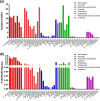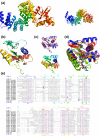Identification and phylogenetic analysis of RNA binding domain abundant in apicomplexans or RAP proteins
- PMID: 33656416
- PMCID: PMC8190603
- DOI: 10.1099/mgen.0.000541
Identification and phylogenetic analysis of RNA binding domain abundant in apicomplexans or RAP proteins
Abstract
The RNA binding domain abundant in apicomplexans (RAP) is a protein domain identified in a diverse group of proteins, called RAP proteins, many of which have been shown to be involved in RNA binding. To understand the expansion and potential function of the RAP proteins, we conducted a hidden Markov model based screen among the proteomes of 54 eukaryotes, 17 bacteria and 12 archaea. We demonstrated that the domain is present in closely and distantly related organisms with particular expansions in Alveolata and Chlorophyta, and are not unique to Apicomplexa as previously believed. All RAP proteins identified can be decomposed into two parts. In the N-terminal region, the presence of variable helical repeats seems to participate in the specific targeting of diverse RNAs, while the RAP domain is mostly identified in the C-terminal region and is highly conserved across the different phylogenetic groups studied. Several conserved residues defining the signature motif could be crucial to ensure the function(s) of the RAP proteins. Modelling of RAP domains in apicomplexan parasites confirmed an ⍺/β structure of a restriction endonuclease-like fold. The phylogenetic trees generated from multiple alignment of RAP domains and full-length proteins from various distantly related eukaryotes indicated a complex evolutionary history of this family. We further discuss these results to assess the potential function of this protein family in apicomplexan parasites.
Keywords: RAP domain; RNA-binding protein; phylogenetic tree; protein structure.
Conflict of interest statement
The authors declare that there are no conflicts of interest.
Figures





References
-
- WHO World Malaria Report. Geneva: World Health Organization; 2019.
Publication types
MeSH terms
Substances
Grants and funding
LinkOut - more resources
Full Text Sources
Other Literature Sources

